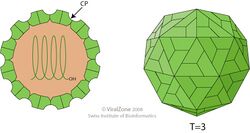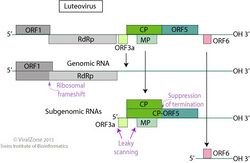Biology:Luteoviridae
| Luteoviridae | |
|---|---|

| |
| Virus classification | |
| (unranked): | Virus |
| Realm: | Riboviria |
| Kingdom: | Orthornavirae |
| Phylum: | Kitrinoviricota |
| Class: | Tolucaviricetes |
| Order: | Tolivirales |
| Family: | Luteoviridae |
| Genera | |
Luteoviridae is a family of viruses. Plants serve as natural hosts. There are currently 51 species in this family, divided among three genera, with seven unassigned species. Diseases associated with this family include: yellowing symptoms.[1][2]
Taxonomy
The following genera are recognized:
The following species are unassigned to a genus:
- Barley yellow dwarf virus GPV
- Barley yellow dwarf virus SGV
- Chickenpea stunt disease associated virus
- Groundnut rosette assistor virus
- Indonesian soybean dwarf virus
- Sweet potato leaf speckling virus
- Tobacco necrotic dwarf virus
Structure
Viruses in Luteoviridae are non-enveloped, with icosahedral and Spherical geometries, and T=3 symmetry. The diameter is around 25-30 nm.
Genomes are linear and non-segmented, around 5.3-5.7kb in length.[1] Luteoviruses can act as helper viruses for Umbraviruses, providing them with a coat protein.[2]
| Genus | Structure | Symmetry | Capsid | Genomic arrangement | Genomic segmentation |
|---|---|---|---|---|---|
| Luteovirus | Icosahedral | T=3 | Non-enveloped | Linear | Monopartite |
| Polerovirus | Icosahedral | T=3 | Non-enveloped | Linear | Monopartite |
| Unassigned | Head-Tail | T=16 | Non-enveloped | Linear | Monopartite |
| Enamovirus | Icosahedral | T=3 | Non-enveloped | Linear | Monopartite |
Life cycle
Viral replication is cytoplasmic. Entry into the host cell is achieved by penetration into the host cell. Replication follows the positive stranded RNA virus replication model. Positive stranded rna virus transcription is the method of transcription. Translation takes place by leaky scanning, -1 ribosomal frameshifting, and suppression of termination. The virus exits the host cell by tubule-guided viral movement. Plants serve as the natural host. The virus is transmitted via a vector (insects). Transmission routes are vector and mechanical.[1]
| Genus | Host details | Tissue tropism | Entry details | Release details | Replication site | Assembly site | Transmission |
|---|---|---|---|---|---|---|---|
| Luteovirus | Plants | Phloem | Viral movement; mechanical inoculation | Viral movement | Cytoplasm | Cytoplasm | Mechanical inoculation: aphids |
| Polerovirus | Plants | Phloem | Viral movement; mechanical inoculation | Viral movement | Cytoplasm | Cytoplasm | Mechanical inoculation: aphids |
| Unassigned | Bacteria | None | Injection | Lysis | Cytoplasm | Cytoplasm | Passive diffusion |
| Enamovirus | Plants | Phloem | Viral movement; mechanical inoculation | Viral movement | Cytoplasm | Cytoplasm | Mechanical inoculation: aphids |
References
External links
- Viralzone: Luteoviridae
- "Luteoviridae - Positive Sense RNA Viruses - Positive Sense RNA Viruses (2011)". http://talk.ictvonline.org/ictv-reports/ictv_9th_report/positive-sense-rna-viruses-2011/w/posrna_viruses/265/luteoviridae.
- ICTVdB - The Universal Virus Database, version 3. https://www.ncbi.nlm.nih.gov/ICTVdb/ICTVdB/
Wikidata ☰ Q2733535 entry


